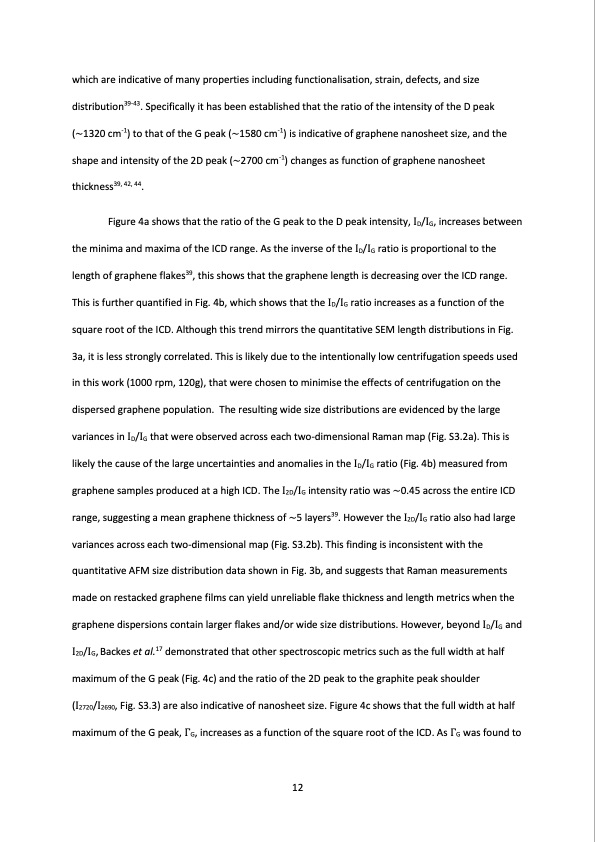PDF Publication Title:
Text from PDF Page: 012
which are indicative of many properties including functionalisation, strain, defects, and size distribution39-43. Specifically it has been established that the ratio of the intensity of the D peak (~1320 cm-1) to that of the G peak (~1580 cm-1) is indicative of graphene nanosheet size, and the shape and intensity of the 2D peak (~2700 cm-1) changes as function of graphene nanosheet thickness39, 42, 44. Figure 4a shows that the ratio of the G peak to the D peak intensity, ID/IG, increases between the minima and maxima of the ICD range. As the inverse of the ID/IG ratio is proportional to the length of graphene flakes39, this shows that the graphene length is decreasing over the ICD range. This is further quantified in Fig. 4b, which shows that the ID/IG ratio increases as a function of the square root of the ICD. Although this trend mirrors the quantitative SEM length distributions in Fig. 3a, it is less strongly correlated. This is likely due to the intentionally low centrifugation speeds used in this work (1000 rpm, 120g), that were chosen to minimise the effects of centrifugation on the dispersed graphene population. The resulting wide size distributions are evidenced by the large variances in ID/IG that were observed across each two-dimensional Raman map (Fig. S3.2a). This is likely the cause of the large uncertainties and anomalies in the ID/IG ratio (Fig. 4b) measured from graphene samples produced at a high ICD. The I2D/IG intensity ratio was ~0.45 across the entire ICD range, suggesting a mean graphene thickness of ~5 layers39. However the I2D/IG ratio also had large variances across each two-dimensional map (Fig. S3.2b). This finding is inconsistent with the quantitative AFM size distribution data shown in Fig. 3b, and suggests that Raman measurements made on restacked graphene films can yield unreliable flake thickness and length metrics when the graphene dispersions contain larger flakes and/or wide size distributions. However, beyond ID/IG and I2D/IG, Backes et al.17 demonstrated that other spectroscopic metrics such as the full width at half maximum of the G peak (Fig. 4c) and the ratio of the 2D peak to the graphite peak shoulder (I2720/I2690, Fig. S3.3) are also indicative of nanosheet size. Figure 4c shows that the full width at half maximum of the G peak, ΓG, increases as a function of the square root of the ICD. As ΓG was found to 12PDF Image | Cavitation Liquid Phase Exfoliation of Graphene

PDF Search Title:
Cavitation Liquid Phase Exfoliation of GrapheneOriginal File Name Searched:
1809-07630.pdfDIY PDF Search: Google It | Yahoo | Bing
Salgenx Redox Flow Battery Technology: Power up your energy storage game with Salgenx Salt Water Battery. With its advanced technology, the flow battery provides reliable, scalable, and sustainable energy storage for utility-scale projects. Upgrade to a Salgenx flow battery today and take control of your energy future.
CONTACT TEL: 608-238-6001 Email: greg@infinityturbine.com (Standard Web Page)